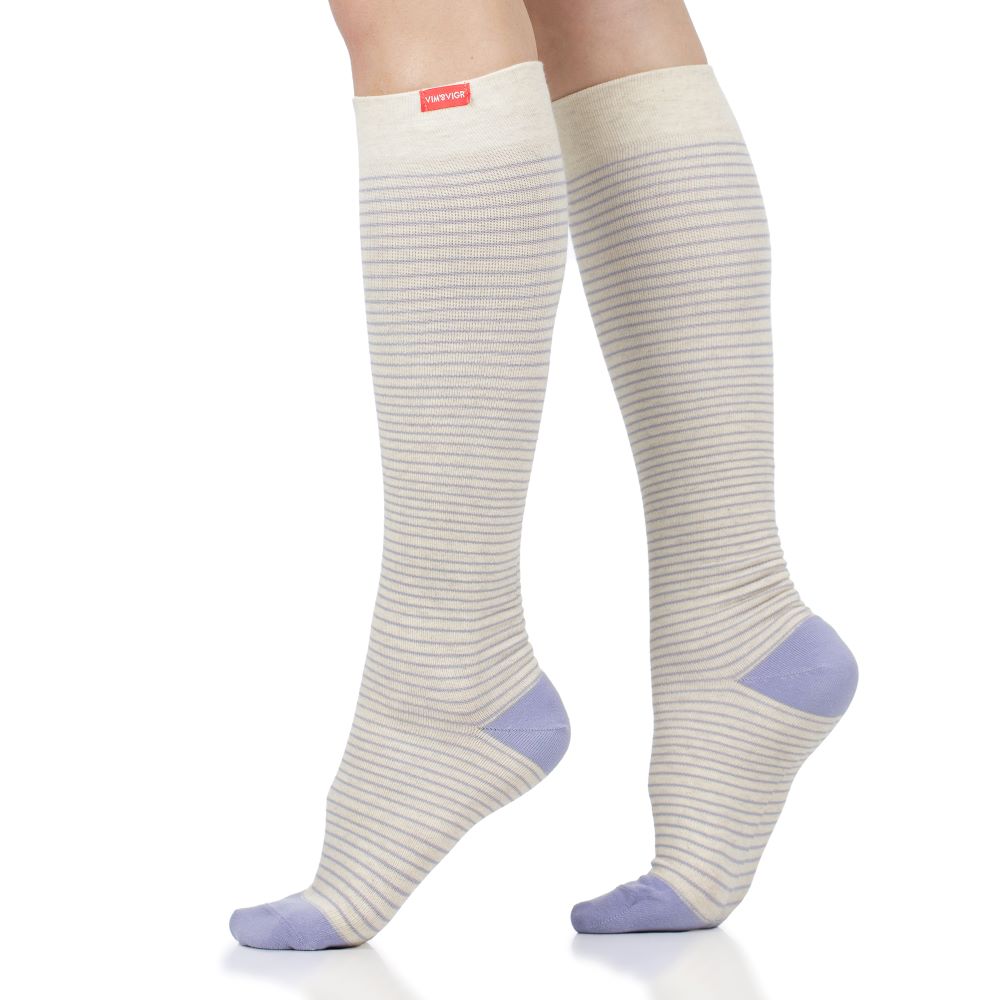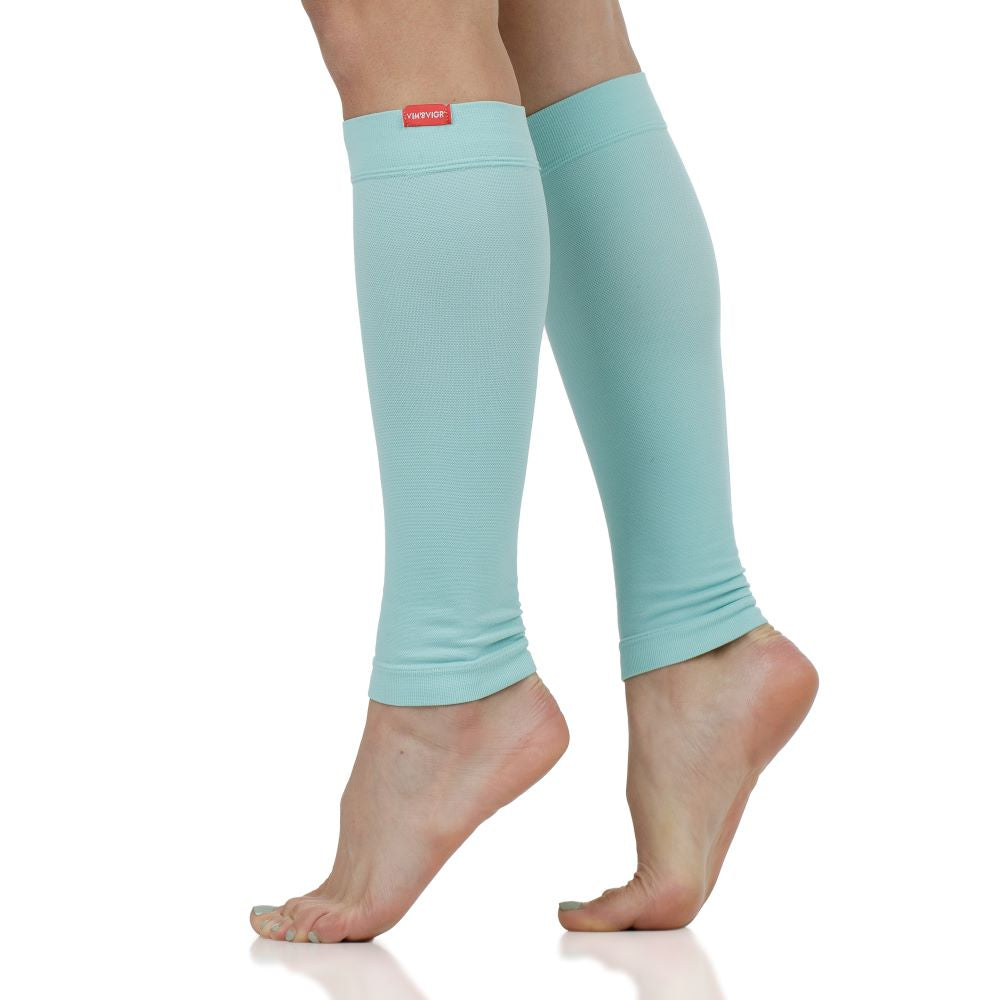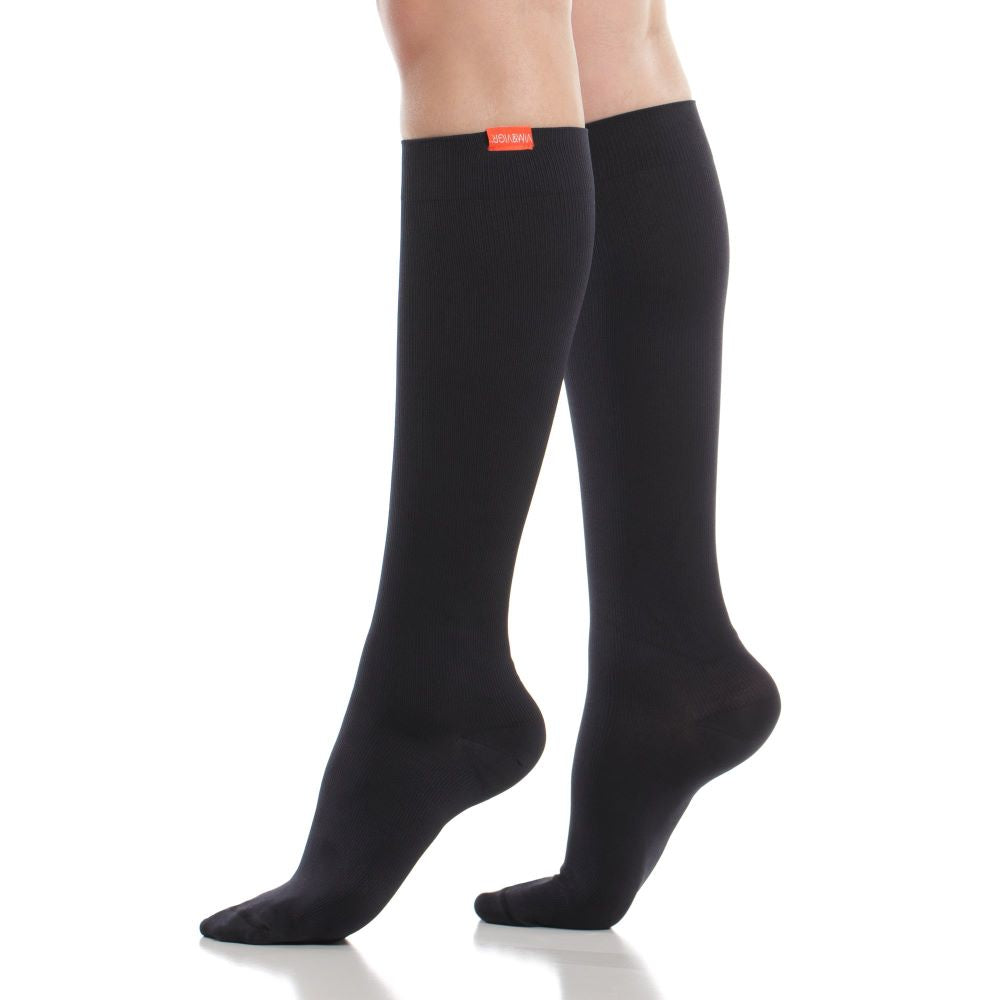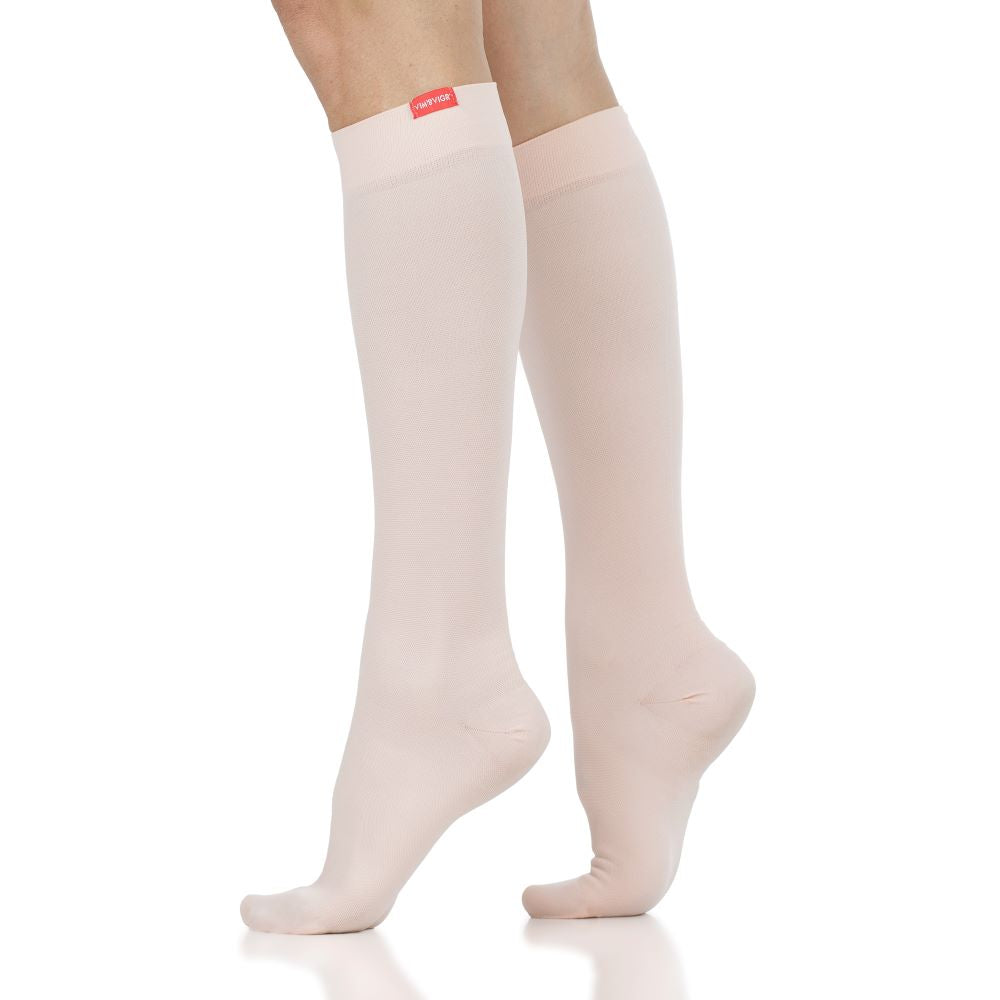How Long to Wear Compression Socks After Surgery
After undergoing surgery, patients are often advised to wear compression socks or stockings to prevent swelling and other complications. The therapeutic pressure these garments apply is known to improve blood flow in the legs. Compression socks push blood out of the legs and towards the heart to counteract the negative effects of extended times resting after surgery.
While mobility levels of patients following a surgery varies depending on the procedure, maintaining a healthy blood flow is essential for recovery. One medical report indicates that it is recommended to wear compression socks or stockings to reduce the swelling in your feet, calves, ankles, and thighs. Medical research discusses essential preventative benefits of using compression socks after surgery. That article reports that the risk of deep vein thrombosis is 20% after a major surgery and 40% after orthopedic surgery. Compression socks are known to reduce or eliminate that risk, according to a 2018 review of the scientific literature.
But how long should you wear compression socks after surgery and what happens if you stop too soon or don’t wear them enough? Requirements vary based on your situation and the surgery you’ve gone through. It’s important to help prevent complications as much as possible by using a preventative tool like compression.
Read on to learn about surgery-specific recommendations, what the risks are if you don’t wear compression socks, and how to pick the best pair for your situation.
How Long Should I Wear Compression Socks After Surgery?
The answer to this question depends on the surgery you had. However, it is commonly recommended that you should wear compression socks for 4-6 weeks after surgery. Smaller, less invasive surgeries have a faster recovery time and require less time in compression socks. But larger knee, hip, and other major surgeries have a longer recovery time and may require you to wear compression socks for months after surgery. General medical recommendations for wearing compression socks after surgery are:
-
4 to 6 weeks for most cases of major surgery (a common time for post-operative follow-ups)
-
1-2 weeks for minor surgery where the risk of deep vein thrombosis (DVT) is lower
For more invasive interventions, such as hip replacement surgery, doctors will often prescribe compression wear even beyond the 6 weeks to help with rehabilitation and mobility.
Smaller, sports related injuries can also benefit from compression socks, read more about that here.
You can wear compression socks for as long as you are comfortable. You can wear compression socks 24 hours a day if you wanted to get the most out of your compression socks. We recommend changing socks daily to keep your feet clean. The same rules apply for recovery from surgery. Pressure from compression socks can be high, but medical experts recommend them because compression socks are known to manage pain and post-surgery complications. Be sure to take breaks if you feel uncomfortable.
Surgery-Specific Guidelines
How long you should wear compression socks to help your circulation and reduce the risk of DVT largely depends on the type of surgery (major or minor), your overall medical condition, and how your recovery is progressing. Here are some common timescales provided by medical research. However, remember that you should consult with your doctor for your case, and you may need to adjust as you go along.
How Long To Wear Compression Socks After Knee Surgery
Knee surgery leads to reduced mobility and can mean that you won’t be walking or exercising for months. You will also have an extended period of rehabilitation. As a result, doctors typically advise patients to wear compression socks for around 4-6 weeks after the intervention.
The key risk here is limited movement, which can lead to poor circulation, blood pooling, and swelling in the lower limbs. In extreme cases, this can aggravate and cause deep vein thrombosis. Compression socks promote blood flow back to the heart and reduce these risks, so they are key to avoiding DVT according to this systematic review. Further, this report recommends wearing compression for at least 5 weeks following knee surgery to reduce the risk of DVT.
If you are at risk of DVT because of your medical history, your doctor may advise you to continue wearing graduated compression socks for up to 12 weeks after knee surgery.
How Long to Wear Compression Socks After Hip Surgery
Since hip surgery severely limits mobility, graduated compression socks are essential for improving blood flow. They help make up for the lack of movement and reduce the risk of DVT and edema. Generally, patients should wear compression socks for at least 5 weeks after such a surgery in at low risk of bleeding, according to this research report. High-risk patients may be advised to wear them for up to 12 weeks. If you find compression to be uncomfortable, talk with your doctor about alternatives, but try to wear compression for a minimum of 2 weeks. Researchers found that approximately 2 weeks of compression after hip arthroplasty can reduce your risk of blood clots or DVT by nearly 30%.
Stylish compression socks for post-surgery recovery are a click away.

How Long to Wear Compression Socks After Abdominal Surgery or C-Section
To prevent DVT and venous stasis in patients who undergo abdominal surgery or laproscopy, compression socks should be worn for at least 2 to 4 weeks, which is the general recommendation of wearing compression after minor surgeries.
In the case of women who have undergone a C-section, one study has found that the risk of venous thromboembolic events was 4 times higher than for those who had had vaginal deliveries. Because of this, doctors recommend compression therapy - patients should wear compression socks or stockings after a C-section for 2 to 6 weeks, depending on the risk of clotting disorders.
How Long to Wear Compression Socks After Shoulder Surgery
To prevent blood clots and DVT, it’s always a good idea to wear compression socks even when the surgery is not in the lower body. For example, a 2011 study found that although the risk of complications for shoulder surgery patients was low, that study found that DVT risk could be reduced by wearing compression socks, especially if there is a history of previous DVT or a family history of clotting disorders.
With compression therapy for 2 to 4 weeks after surgery, you’ll have better control over fluid retention and swelling in the limbs, as well as a better overall circulation.
Is It Ok to Sleep in Compression Socks After Surgery?
Yes, compression socks are safe to sleep in and wear for as long as you feel comfortable. After surgery, you should wear compression socks at night and sleeping in them is ok if you’re comfortable enough.
Compression socks are easy to wear and can be personalized to fit comfortably around your legs. This is why, at Vim & Vigr, we offer 6 different sizes and 4 different fabric types. Having the right size for you at the appropriate level of pressure will mean that you’re comfortable enough to wear your pair of graduated compression socks to bed to maximize the benefits of wearing them.
Experience soft merino wool compression socks to relax and even sleep in.

What Happens if You Don’t Wear Compression Socks After Surgery?
Multiple medical research studies have highlighted the risk of blood clots and deep vein thrombosis in patients who are immobile for weeks after surgery. The lack of movement causes blood pooling in the limbs, which leads to swelling, discomfort, and the risk of medical conditions like blood clots and DVT. From post-abdominal surgery to knee replacements, compression stockings and socks have been found to lower circulatory risks and improve comfort overall.If you’re not used to wearing them, it’s understandable that you may be apprehensive about using compression socks. However, if you start with just 2-3 hours of wear at a time and slowly increase this as you feel comfortable, you’ve got a better chance of improving your circulation and reducing significant health risks.
What Happens If You Stop Wearing Compression Socks Too Soon After Surgery?
Compression socks are largely a preventative tool. They are effective against swelling, blood clots, and deep vein thrombosis, among other complications. So, if you stop wearing compression socks too soon after surgery, you can increase your risk of:
-
Pain or Bruising
-
Swelling
-
Blood Clots
-
Deep Vein Thrombosis (DVT)
-
Longer Recovery Time
-
Other Health Complications
Deep vein thrombosis or a pulmonary embolism (a blood clot in the lungs that most often forms from a clot that's broken off from the leg, arm, or stomach) are major risks that can occur due to poor circulation after surgery. Compression is well-known to reduce the risk of DVT or other issues with blood clots.
Always consult with your doctor on their compression sock recommendations. Generally, wearing them consistently for 4-6 weeks (about 1 and a half months) after surgery to give you the benefits you need to prevent circulation problems. It is important for you to know that you will have better results if you wear compression garments every day for at a minimum of 3 weeks, according to this research study. But listen to your body if you need breaks from wearing compression socks, removing them for a couple hours.
When to Remove Compression Socks After Surgery
Depending on the surgery you’re recovering from and your overall medical condition, you can stop wearing compression socks every day after:
-
6 weeks after knee surgery
-
6 to 12 weeks after hip surgery
-
2 to 6 weeks after abdominal surgery or a C-section
-
2 to 4 weeks after shoulder surgery
These are just general guidelines, however. You may find that during your rehabilitation, wearing graduated compression socks every day gives you better stability and support for the joints, making it easier to go back to walking or running. You can also benefit from compression for the entire leg and abdominal area by switching to compression tights.
Can You Wear Compression Socks for Too Long After Surgery?
If you do not have a medical condition that prevents you from wearing compression socks, compression socks are safe to wear after surgery for as long as you are comfortable wearing them. It's important to remember that the benefits of compression socks don’t become apparent immediately. So, wearing them for several weeks or months after surgery is a good idea to prevent complications during your healing process. As always, be sure to consult your doctor or medical professional for their recommendation.
Why Wear Compression Socks After Surgery?
After you’ve undergone surgery, you often need to spend time bed-ridden or with reduced activity levels (depending on the body part that’s been operated on, of course). During this time, there is a higher risk of developing blood clots and of the blood pooling in the lower extremities (which causes painful swelling), because of lack of movement. Compression socks reduce this risk by applying pressure to the lower legs, improving circulation (according to a scientific study), and helping ensure there is no pooling of blood or other fluid.
Graduated compression socks help push the blood from the legs towards the heart. This helps stimulate healthy circulation throughout the body. As a result, enough oxygen and nutrients travel to your whole body, helping you recover and making you feel better overall. Compression socks can even reduce discomfort, swelling, or pain.
Reducing Swelling
Thanks to the therapeutic pressure they apply to the lower legs, graduated compression socks massage the muscles and support the veins. This reduces the risk of blood and fluid pooling in the extremities when you’re not moving around as much after surgery. As a result, you’ll experience less swelling and discomfort.
Improving Circulation
A 2016 systematic review of the use of compression stockings to prevent DVT in surgical patients establishes the key role of these garments in improving circulation. Knee-length compression socks were found to prevent venous stasis, reducing the risk of postoperative complications. They are also the type of compression garment most favored by patients thanks to their versatility, ease of use, and comfort when compared to other compression garments.
Preventing Blood Clots
Regardless of the surgery you’ve undergone, the recovery period involves reduced mobility, which can cause blood to pool in the lower legs and blood clots to form. For example, a study of 175 patients that underwent shoulder surgery found that the risk of deep vein thrombosis was present. Therefore, using compression socks may lower the risk of DVT and improve venous circulation after their surgery.
By wearing compression socks, you improve venous return, which can benefit circulation of blood throughout the body. This is essential to reduce the risk of blood clots and their more dangerous complications.
The Best Compression Socks to Wear After Surgery
To make the best use of your compression socks post-surgery, you need to be comfortable and ensure the socks fit you well and apply the correct level of compression. Here’s what you need to know to ensure this.
Choosing the Right Compression Level
Doctor or surgical care teams often recommend a 20-30 mmHg compression sock, or “medium” compression. Compression levels describe the amount of therapeutic pressure you will feel around your legs.
If the “squeeze” feels like too much, you may still benefit from lower pressures like 15-20 mmHg. On the other hand, you may need higher pressure like 30-40 mmHg to prevent blood circulation problems. This pressure often requires a prescription.
Fabric and Style Options
Compression socks are extremely versatile, which makes them great recovery tools for patients after surgery. You can opt for different fabrics, depending on your activity levels and the weather. You can also go for wide calf specific socks, open-toe socks, or full-length tights or leggings, depending on your needs.
The right fabric is important, too. At Vim & Vigr, we offer 4 functional fabrics with different benefits:
-
Cotton is soft and versatile, allowing for everyday wear. Our 200-needle count cotton blend is also light and breathable, which makes our socks great all year round.
-
Merino wool is breathable, comfortable, and an excellent thermoregulator, keeping your feet warm in cold weather and dry and cool in the heat. Our socks also feature a seamless toe, ideal if you have sensory issues.
-
Nylon is stretchy and flexible, a good choice for rehabilitation exercises and for going back to sports after your surgery. We offer sleek, flexible designs with exciting patterns, too.
-
Moisture wick nylon is also great for temperature regulation. Vim & Vigr socks are knit on a 400-needle count machine and give the feeling of stockings with a fantastic 4-way stretch.
Sizing and Fit
Compression socks need to be tight-fitting, but not uncomfortable - so the sizing and fit are very important. This is why we offer six different sizes and encourage you to measure your calf circumference and map it against our sizing charts (available for each product) to ensure you have the perfect fit for you.
Additionally, compression socks require a bit of attention when you put them on. We’ve created a detailed guide on how to put on compression socks, including a helpful video. Follow these instructions to ensure there is no folding or bunching and that your socks feel as comfortable as possible.
–
Wearing compression socks after surgery is essential to reduce the risk of deep vein thrombosis, blood clots, and other complications. With these garments, you counteract the negative effects of being immobile for extended periods of time while you recover, no matter what type of surgery you’ve just had. They are also great during the rehabilitation period and as you return to normal levels of activity.
Browse our compression socks and consult with your doctor to start feeling the benefits as soon as you’re out of your surgery.
References:
Badireddy M. & Mudipalli V.R. (2023). Deep Venous Thrombosis Prophylaxis. In: StatPearls [Internet]. Treasure Island (FL): StatPearls Publishing. Read it here.
Block J. E. (2010). Cold and compression in the management of musculoskeletal injuries and orthopedic operative procedures: a narrative review. Open access journal of sports medicine, 1, 105–113. Read it here.
Blondon, M., Casini, A., Hoppe, K. K., Boehlen, F., Righini, M., & Smith, N. L. (2016). Risks of Venous Thromboembolism After Cesarean Sections: A Meta-Analysis. Chest, 150(3), 572–596. Read it here.
Charles, T., Mackintosh, D., Healy, B., Perrin, K., Weatherall, M., & Beasley, R. (2011). Merino wool graduated compression stocking increases lower limb venous blood flow: a randomized controlled trial. Advances in therapy, 28(3), 227–237. Read it here.
Huang, T. W., Chen, S. L., Bai, C. H., Wu, C. H., & Tam, K. W. (2013). The optimal duration of compression therapy following varicose vein surgery: a meta-analysis of randomized controlled trials. European journal of vascular and endovascular surgery: the official journal of the European Society for Vascular Surgery, 45(4), 397–402. Read it here.
Kwak, H. S., Cho, J. H., Kim, J. T., Yoo, J. J., & Kim, H. J. (2017). Intermittent Pneumatic Compression for the Prevention of Venous Thromboembolism after Total Hip Arthroplasty. Clinics in orthopedic surgery, 9(1), 37–42. Read it here.
Lim, C. S., & Davies, A. H. (2014). Graduated compression stockings. CMAJ: Canadian Medical Association journal = journal de l'Association medicale canadienne, 186(10), E391–E398. Read it here.
McNally, M. A., & Mollan, R. A. (1993). Total hip replacement, lower limb blood flow and venous thrombogenesis. The Journal of bone and joint surgery. British volume, 75(4), 640–644. Read it here.
Mosti G. (2013). Post-treatment compression: duration and techniques. Phlebology, 28 Suppl 1, 21–24. Read it here.
Ojike, N. I., Bhadra, A. K., Giannoudis, P. V., & Roberts, C. S. (2011). Venous thromboembolism in shoulder surgery: a systematic review. Acta orthopaedica Belgica, 77(3), 281–289. Read it here.
Phillips, S. M., Gallagher, M., & Buchan, H. (2008). Use graduated compression stockings postoperatively to prevent deep vein thrombosis. BMJ (Clinical research ed.), 336(7650), 943–944. Read it here.
Sachdeva, A., Dalton, M., & Lees, T. (2018). Graduated compression stockings for prevention of deep vein thrombosis. The Cochrane database of systematic reviews, 11(11), CD001484. Read it here.
Sajid, M. S., Desai, M., Morris, R. W., & Hamilton, G. (2012). Knee length versus thigh length graduated compression stockings for prevention of deep vein thrombosis in postoperative surgical patients. The Cochrane database of systematic reviews, 2012(5), CD007162. Read it here.
Takahashi, H., Yamamoto, N., Nagamoto, H., Sano, H., Tanaka, M., & Itoi, E. (2014). Venous thromboembolism after elective shoulder surgery: a prospective cohort study of 175 patients. Journal of shoulder and elbow surgery, 23(5), 605–612. Read it here.
Weiss, R. A., Sadick, N. S., Goldman, M. P., & Weiss, M. A. (1999). Post-sclerotherapy compression: controlled comparative study of duration of compression and its effects on clinical outcome. Dermatologic surgery: official publication for American Society for Dermatologic Surgery [et al.], 25(2), 105–108. Read it here.
Zhou, X., Gong, S., Liang, W., & Hu, J. (2020). Elastic stockings plus enoxaparin and intermittent pneumatic compression in preventing postoperative deep venous thrombosis in patients with ovarian cancer. Int J Clin Exp Med 13(4), 2717-2723. Read it here.

















Understanding the optimal duration for wearing compression socks after surgery can have a significant impact on recovery. Your article provides valuable clarity on this topic, making it exceptionally helpful. https://drmarkkohout.com.au/
Hello vimvigr.com admin, Your posts are always well-written and engaging.
Thank you. Answer was very helpful.
Leave a comment